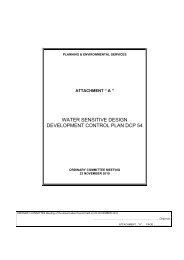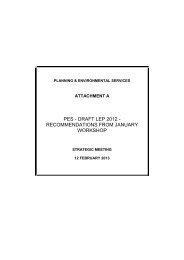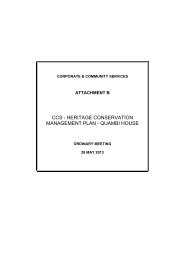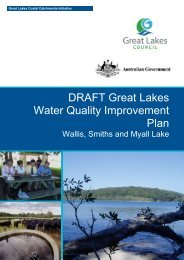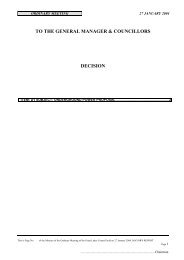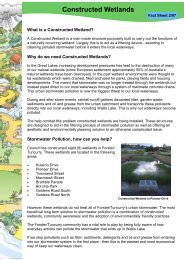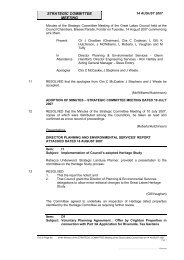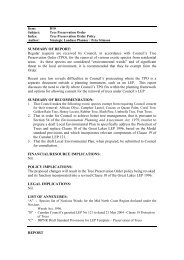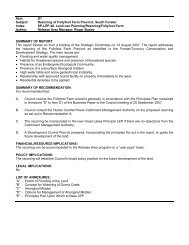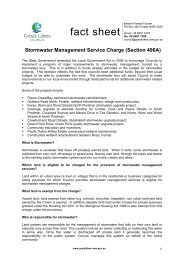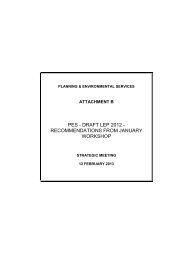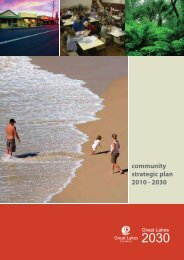smiths lake planning study volume 1: text - Great Lakes Council
smiths lake planning study volume 1: text - Great Lakes Council
smiths lake planning study volume 1: text - Great Lakes Council
Create successful ePaper yourself
Turn your PDF publications into a flip-book with our unique Google optimized e-Paper software.
FLOODING AND DRAINAGE 30<br />
The AWACS <strong>study</strong> concluded that the elevated ocean levels for Old Bar are those listed in<br />
Table 3-2. However, due to this <strong>study</strong> being completed in 1989, it did not account for the<br />
Greenhouse Effect. Hence, a conservative value of 0.2m is added to the Old Bar values to<br />
derive appropriate levels for <strong>planning</strong> purposes.<br />
Average Recurrence<br />
Interval (years)<br />
Table 3-2 Elevated Ocean Levels<br />
Old Bar Levels (mAHD)<br />
(from AWACS, 1989)<br />
Recommended Smiths<br />
Lake Levels (mAHD)<br />
20 1.9 2.1<br />
50 2.0 2.2<br />
100 2.1 2.3<br />
During a cyclonic event that would result in such elevated ocean levels, it is conceivable that<br />
ocean water would flow into Smiths Lake with little hindrance from the entrance. Hence, it<br />
could be conservatively assumed that these ocean levels are a useful guide for extreme levels<br />
within Smiths Lake.<br />
In considering the combination of runoff into Smiths Lake adding to these levels, it needs to be<br />
recognised that the resulting <strong>lake</strong> level will only be sufficient to maintain the hydraulic gradient<br />
from the <strong>lake</strong> to the ocean for draining the catchment runoff. Given the relative efficiency of<br />
the entrance (ie. compared with a river), it is unlikely that this level will be significantly higher<br />
than that in the ocean.<br />
It is also possible that a cyclone could result in significant erosion of the entrance. This would<br />
allow penetration of ocean waves into Smiths Lake causing higher levels of inundation due to<br />
wave setup on the east-facing shores. However, to quantify and confirm this phenomena is a<br />
complex task requiring consideration of such issues as <strong>lake</strong> bathymetry, storm orientation and<br />
entrance conditions. It is suggested that assessment of this issue could be included in a coastal<br />
hazard <strong>study</strong>.<br />
3.2.2 Creek Flooding<br />
RAFTS-XP Modelling<br />
As described in Section 3.1.1, there are a number of watercourses in the SLA. The flood flows<br />
associated with these catchments were analysed using the runoff routing program RAFTS-XP.<br />
Each of the major catchments was modelled using site characteristics such as area, slope, creek<br />
shape, degree of urbanisation and vegetation cover.<br />
1% AEP Design Flows<br />
Using the design rainfall data presented in Section 3.1.2, design flood events were simulated<br />
using the RAFTS-XP models of the catchments. The critical durations for the catchments were<br />
in the order of one hour. The peak flows for the 1% AEP flood events are shown in Figure 3-2<br />
for the major catchments.<br />
SMITHS_LAKE_PLANNING_STUDY.DOC<br />
O C E A N I C S<br />
A U S T R A L I A




